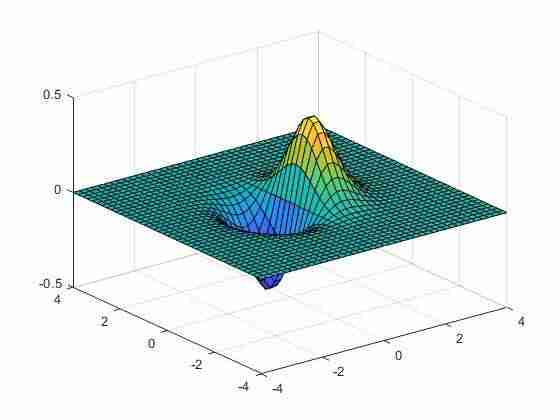今天在看点目标成像仿真程序的时候,看到了meshgrid函数,看了matlab的帮助文档后理解了一点,特此记录学习过程。
目录
一、meshgrid函数二、举例验证 三、创建二维网格绘制曲面图四、总结五、meshgrid函数源代码(仅供参考):
一、meshgrid函数
meshgrid函数是MATLAB中用于生成网格采样点数的函数,通常进行2D、3D图形的绘制。
1、【X,Y】 = meshgrid(x,y) :基于向量x和y中包含的坐标返回二维网格坐标。X是一个矩阵,每一行是x的一个副本,Y也是一个矩阵,每一列是y的一个副本。坐标X和Y表示的网格有length(y)个行和length(x)个列。
2 、[X,Y] = meshgrid(x) 与 [X,Y] = meshgrid(x,x)相同,返回网格大小为length(x)*length(x)的方形网格矩阵。
3、 [X,Y,Z] = meshgrid(x,y,z),返回由向量x,y,z定义的三维网格坐标,X,Y和Z表示的网格大小为length(x)*length(y)*length(z)。
二、举例验证
1.【X,Y】 = meshgrid(x,y) , 代码如下:
a 、b矩阵个数相同:
a = [1 2 3 4];b = [5 6 7 8];[A,B] = meshgrid(a,b)结果:
A = 1 2 3 4 1 2 3 4 1 2 3 4 1 2 3 4B = 5 5 5 5 6 6 6 6 7 7 7 7 8 8 8 8>> a 、b矩阵数量不同:
a = [1 2 3];b = [4 5 6 7];[A,B] = meshgrid(a,b)A = 1 2 3 1 2 3 1 2 3 1 2 3B = 4 4 4 5 5 5 6 6 6 7 7 7>> 2、【X,Y】 = meshgrid(x), 代码如下:
x = [1 2 3];[X,Y] = meshgrid(x)X = 1 2 3 1 2 3 1 2 3Y = 1 1 1 2 2 2 3 3 3>>x = [1 2 3];>> [X,Y] = meshgrid(x,x)X = 1 2 3 1 2 3 1 2 3Y = 1 1 1 2 2 2 3 3 3>> 三、创建二维网格绘制曲面图
使用均匀分布的x和y坐标在-4到4之间创建二维网格:
代码如下:
x = -4:0.2:4;y = x;[X,Y] = meshgrid(x);F = X.*exp(-X.^2 - Y.^2);surf(X,Y,F);
四、总结
为什么要使用meshgrid?
matlab使用矩阵的方式进行运算,对于2D而言,如果采样10个点(指x,y轴),那么对于x=第一个采样点,反映到矩阵就是10个,即不管y是哪个值,x的第一采样点保持不变;对y是同理。因此,2D产生的x和y都是两维矩阵。
五、meshgrid函数源代码(仅供参考):
源代码:function [xx,yy,zz] = meshgrid(x,y,z)%MESHGRID Cartesian grid in 2-D/3-D space% [X,Y] = MESHGRID(xgv,ygv) replicates the grid vectors xgv and ygv to% produce the coordinates of a rectangular grid (X, Y). The grid vector% xgv is replicated numel(ygv) times to form the columns of X. The grid% vector ygv is replicated numel(xgv) times to form the rows of Y.%% [X,Y,Z] = MESHGRID(xgv,ygv,zgv) replicates the grid vectors xgv, ygv, zgv% to produce the coordinates of a 3D rectangular grid (X, Y, Z). The grid% vectors xgv,ygv,zgv form the columns of X, rows of Y, and pages of Z% respectively. (X,Y,Z) are of size numel(ygv)-by-numel(xgv)-by(numel(zgv).%% [X,Y] = MESHGRID(gv) is equivalent to [X,Y] = MESHGRID(gv,gv).% [X,Y,Z] = MESHGRID(gv) is equivalent to [X,Y,Z] = MESHGRID(gv,gv,gv).%% The coordinate arrays are typically used for the evaluation of functions% of two or three variables and for surface and volumetric plots.%% MESHGRID and NDGRID are similar, though MESHGRID is restricted to 2-D% and 3-D while NDGRID supports 1-D to N-D. In 2-D and 3-D the coordinates% output by each function are the same, the difference is the shape of the% output arrays. For grid vectors xgv, ygv and zgv of length M, N and P% respectively, NDGRID(xgv, ygv) will output arrays of size M-by-N while% MESHGRID(xgv, ygv) outputs arrays of size N-by-M. Similarly,% NDGRID(xgv, ygv, zgv) will output arrays of size M-by-N-by-P while% MESHGRID(xgv, ygv, zgv) outputs arrays of size N-by-M-by-P.%% Example: Evaluate the function x*exp(-x^2-y^2)% over the range -2 < x < 2, -4 < y < 4,%% [X,Y] = meshgrid(-2:.2:2, -4:.4:4);% Z = X .* exp(-X.^2 - Y.^2);% surf(X,Y,Z)%%% Class support for inputs xgv,ygv,zgv:% float: double, single% integer: uint8, int8, uint16, int16, uint32, int32, uint64, int64%% See also SURF, SLICE, NDGRID.% Copyright 1984-2013 The MathWorks, Inc.if nargin==0 || (nargin > 1 && nargout > nargin)error(message('MATLAB:meshgrid:NotEnoughInputs'));endif nargin == 2 || (nargin == 1 && nargout < 3) % 2-D array caseif nargin == 1y = x;endif isempty(x) || isempty(y)xx = zeros(0,class(x));yy = zeros(0,class(y));elsexrow = full(x(:)).'; % Make sure x is a full row vector.ycol = full(y(:)); % Make sure y is a full column vector.xx = repmat(xrow,size(ycol));yy = repmat(ycol,size(xrow));endelse % 3-D array caseif nargin == 1y = x;z = x;endif isempty(x) || isempty(y) || isempty(z)xx = zeros(0,class(x));yy = zeros(0,class(y));zz = zeros(0,class(z));elsenx = numel(x);ny = numel(y);nz = numel(z);xx = reshape(full(x),[1 nx 1]); % Make sure x is a full row vector.yy = reshape(full(y),[ny 1 1]); % Make sure y is a full column vector.zz = reshape(full(z),[1 1 nz]); % Make sure z is a full page vector.xx = repmat(xx, ny, 1, nz);yy = repmat(yy, 1, nx, nz);zz = repmat(zz, ny, nx, 1);endend